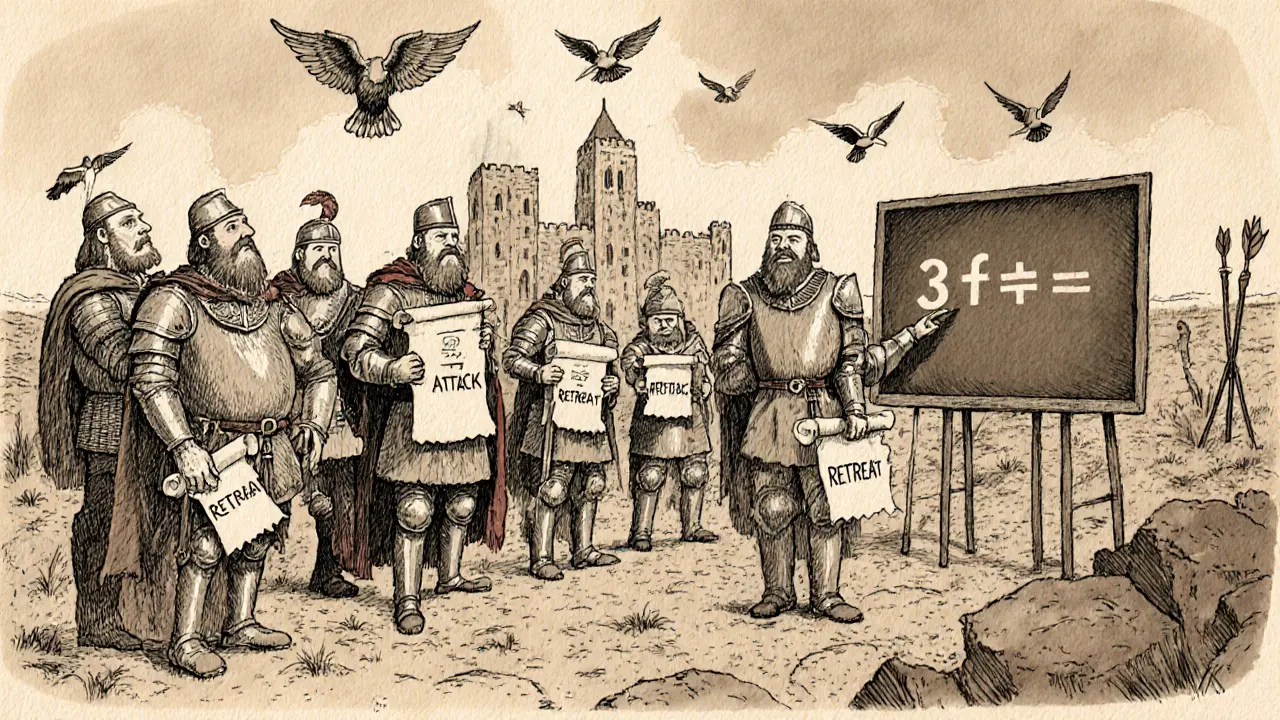
Byzantine Fault Tolerance Calculator
How Many Nodes Do You Need?
Calculate the minimum number of nodes required to achieve Byzantine Fault Tolerance (BFT) based on the number of expected faulty nodes. The Byzantine Generals Problem requires at least 3f + 1 total nodes where f is the number of faulty nodes.
Result
To achieve Byzantine Fault Tolerance with 0 faulty nodes, you need at least 0 nodes.
The Byzantine Generals Problem isn’t just a fancy name from a computer science textbook-it’s the reason your Bitcoin transactions work, even when some people online are trying to cheat. Imagine ten generals, each commanding a separate army, surrounding a city. They need to agree: attack at the same time, or retreat together. But some of these generals are traitors. They might send conflicting messages-telling one group to attack while telling another to retreat. The messengers carrying these orders could be intercepted, lied to, or corrupted. How do the loyal generals make sure they all do the same thing, even when some messages are fake?
This isn’t a medieval war story. It’s the exact problem that every blockchain has to solve. In Bitcoin, Ethereum, or any decentralized network, there’s no boss telling everyone what to do. Instead, hundreds or thousands of computers (called nodes) have to agree on one version of the truth-like which transactions are real and which are fake. But some of those nodes might be hacked, malfunctioning, or intentionally malicious. The Byzantine Generals Problem asks: Can you reach reliable agreement in a system where some participants can lie? And the answer, after decades of research, is yes-but only under strict conditions.
How the Problem Works: Math Behind the Chaos
The original 1982 paper by Leslie Lamport, Robert Shostak, and Marshall Pease laid out the rules clearly. For a group of generals to reach consensus despite traitors, you need at least 3f + 1 total generals, where f is the number of traitors. So if you suspect one traitor, you need four generals total. If you think three might be lying, you need ten. It’s not a suggestion-it’s a mathematical guarantee. If you have fewer than that, no protocol can protect you from being fooled.
Why 3f+1? Because each loyal general needs to cross-check what others are saying. If a traitor sends different messages to different generals, the loyal ones must outnumber the traitors by at least 2-to-1 to spot the inconsistency. Think of it like a jury. If two jurors are lying and trying to frame someone, you need at least five honest jurors to see through the trick-three to agree on the truth, and two extra to break the tie.
This is why blockchain networks can’t just have five nodes. If one goes rogue, you need at least seven. That’s why small private blockchains often fail-they don’t have enough nodes to handle even one bad actor. Public blockchains like Bitcoin and Ethereum have thousands because they assume anyone could be a traitor.
Crash Fault vs. Byzantine Fault: The Difference That Matters
Not all system failures are the same. In simpler distributed systems, like a company’s internal database, nodes usually just crash-they stop working. That’s called a crash fault. Algorithms like Paxos or Raft handle those fine. You just need a majority: if you have five servers and two crash, the other three can still run things.
But in a blockchain, the problem is worse. Nodes don’t just go offline-they can send fake data. A hacker could control a node and broadcast false transactions. Or a miner might try to double-spend coins. That’s a Byzantine fault. And that’s why Paxos won’t cut it. You need something stronger: Byzantine Fault Tolerance (BFT).
The math is unforgiving. For crash faults, you need n > 2f+1. For Byzantine faults, you need n > 3f+1. That extra requirement is what makes blockchain so hard to build-and so powerful when it works.
How Bitcoin Solved It (Sort Of)
For 20 years, people thought the Byzantine Generals Problem was unsolvable in open, permissionless networks. Then Bitcoin came along in 2009.
Satoshi Nakamoto didn’t fix the problem with better messaging. He fixed it with money.
Bitcoin’s proof-of-work consensus forces miners to spend real-world resources-electricity, hardware, time-to add blocks. If a miner tries to cheat, they waste their own money. Honest behavior pays. Dishonest behavior costs. This alignment of incentives makes it economically irrational to lie. A traitor would need to control more than half the network’s computing power to successfully attack the chain-and that’s astronomically expensive.
Vitalik Buterin called it the first practical solution to the Byzantine Generals Problem for open networks. And he’s right. Bitcoin proved you don’t need trust-you need cost.
But it’s not perfect. Bitcoin uses about as much electricity as a small country. Critics like Dr. Andrew Miller point out that this energy waste is a trade-off for security. The system works, but at a huge environmental and economic cost.

What Came After: Faster, Greener Solutions
Bitcoin’s solution was groundbreaking, but not scalable. Ethereum, which started with proof-of-work, switched to proof-of-stake in September 2022 with “The Merge.” Now, instead of miners competing with computers, validators stake real ETH to participate. If they act dishonestly, they lose their stake. It’s still BFT-but now it’s based on financial penalties, not energy consumption.
The result? Consensus time dropped from 15 seconds to under a second. Energy use fell by 99.95%. And the network still handles over 5,000 validator nodes with 99.998% reliability.
Other protocols like HotStuff (used in Diem and Chia) and Tendermint (used in Cosmos) cut down the communication overhead. Older BFT systems needed each node to talk to every other node-O(n²) complexity. HotStuff reduced that to O(n), making networks with 10,000+ nodes possible.
And now, researchers are even building quantum-resistant BFT systems. IBM’s Q-BFT, announced in June 2023, is designed to survive attacks from future quantum computers. The problem isn’t solved-it’s evolving.
Real-World Failures and Lessons
It’s not all smooth sailing. Developers who’ve tried to build BFT systems often run into walls.
One developer on GitHub wrote that their 4-node testnet kept failing because one node was behaving oddly. They had to scale to seven nodes to meet the 3f+1 rule. Another Reddit user said implementing PBFT (Practical Byzantine Fault Tolerance) took three months-three times longer than a simple crash-tolerant system.
Performance also drops as you add nodes. Beyond 100 nodes, throughput often falls 15-20% per new node. Network partitions-when parts of the network get disconnected-cause 43% of BFT failures, according to IEEE research.
And yet, companies still push forward. Why? Because the stakes are too high to fail.

Why This Matters Beyond Blockchain
The Byzantine Generals Problem isn’t just for crypto. It’s for everything that runs on distributed systems.
NASA requires BFT in spacecraft control systems for lunar missions. If one computer sends a wrong course correction, and others believe it, the mission fails. The automotive industry now uses BFT in vehicle-to-vehicle communication-78 of the top 100 suppliers have adopted it to meet ISO 21448:2022 safety standards.
The U.S. Department of Homeland Security just mandated BFT for all new electrical grid control systems by 2026. If hackers can trick a power grid into thinking it’s safe to overload, people die.
Even banks and insurance companies are using BFT in private blockchains to settle trades faster and reduce fraud. The global BFT market is expected to grow from $2.1 billion in 2023 to nearly $10 billion by 2028.
What You Need to Know
You don’t need to code a BFT protocol to understand why it matters. But you should know this:
- Decentralized systems can’t rely on trust-they rely on math and incentives.
- More nodes don’t always mean better security-unless they follow the 3f+1 rule.
- Proof-of-work isn’t the only way. Proof-of-stake is faster, cheaper, and just as secure.
- When a blockchain says it’s “Byzantine fault tolerant,” check how many nodes it requires and what happens if one fails.
The Byzantine Generals Problem isn’t going away. As more of our world runs on distributed systems-power grids, medical devices, self-driving cars-it becomes the invisible foundation of safety and reliability. Understanding it isn’t about being a blockchain expert. It’s about understanding how trust is built in a world where no one is in charge.
What is the Byzantine Generals Problem in simple terms?
It’s a puzzle about how a group of people can agree on a plan when some of them might be lying. Imagine generals trying to attack a city, but some are traitors sending fake messages. The problem asks: How do you make sure everyone follows the same plan, even if some messages are fake? Blockchain solves this by using math and economics to punish liars and reward honesty.
Why is 3f+1 the magic number for Byzantine Fault Tolerance?
It’s the minimum number of nodes needed to outvote traitors. If f is the number of traitors, you need 3f+1 total nodes so that loyal nodes outnumber traitors by at least 2-to-1. This lets honest nodes cross-check messages and spot lies. For example, if one node is malicious, you need at least four total. If three are bad, you need ten. Without this ratio, the system can’t guarantee consensus.
How does Bitcoin solve the Byzantine Generals Problem?
Bitcoin doesn’t rely on trust or perfect communication. It uses proof-of-work: miners spend real money on electricity and hardware to add blocks. If someone tries to cheat, they waste their own money. Honest behavior is profitable. Dishonest behavior is expensive. This economic incentive makes it irrational to lie, even if you control a node. It’s not perfect-it uses massive energy-but it works.
Is proof-of-stake better than proof-of-work for solving this problem?
Yes, for most use cases. Proof-of-stake replaces energy use with financial stakes. Validators lock up cryptocurrency as collateral. If they act dishonestly, they lose their stake. This achieves the same security as proof-of-work but uses 99.95% less energy. Ethereum’s switch to proof-of-stake in 2022 proved it’s faster, cheaper, and just as secure against Byzantine faults.
Where else is Byzantine Fault Tolerance used besides blockchain?
It’s used anywhere distributed systems must be reliable even if some parts fail or lie. NASA uses it in spacecraft control systems. Car manufacturers use it in vehicle communication networks to prevent hacking. Power grids in the U.S. must implement it by 2026. Banks use it for secure transaction settlements. Any system where failure could cost lives or money needs BFT.





Comments (13)
angela sastre
So basically, blockchain is like a group project where everyone has to pay to play, and if you try to cheat, you lose your money? That’s actually kind of genius. I never thought about it like that before.
Patrick Rocillo
🤯 This hit different. Proof-of-work = paying for truth with electricity. Proof-of-stake = paying for truth with your crypto. Either way, you’re putting skin in the game. Bitcoin didn’t solve the problem - it just made lying too expensive to bother with. 🚀
Aniket Sable
bro this is wild… i thought only coders get this stuff. but now i see its just about trust and money. if u cheat u lose. simple. 🤘
Santosh harnaval
3f+1. That’s the rule. No more, no less. Simple math. Real world works this way too.
Will Atkinson
I love how this post breaks it down without jargon - it’s like explaining gravity to someone who’s never seen an apple fall. The fact that we’ve built entire financial systems on this idea, and they mostly work? That’s not luck. That’s brilliance. 🙌
monica thomas
While the technical underpinnings of Byzantine Fault Tolerance are indeed mathematically rigorous, one must also consider the sociological implications of incentivizing honesty through economic means. Is it sustainable? Or merely a temporary equilibrium?
Michael Hagerman
Okay but let’s be real - Bitcoin’s energy use is a crime against humanity. And now we’re all just pretending it’s ‘security’? No. It’s arrogance wrapped in blockchain hype. The fact that people still defend this like it’s sacred is why we’re in trouble.
Meanwhile, Ethereum switched to proof-of-stake and didn’t collapse. Guess what? The world moved on. And you’re still arguing about miners.
Mike Kimberly
What’s fascinating is how this problem echoes beyond tech. In democracy, you need more than a simple majority to prevent manipulation - you need supermajorities, independent oversight, transparency. The 3f+1 rule isn’t just for nodes - it’s for institutions. We’ve been trying to solve the Byzantine Generals Problem in politics for centuries, and we still haven’t cracked it. Maybe the answer isn’t in more votes - but in higher costs to cheat. Imagine if lying in public office cost you your entire net worth. Would we still have scandals? Maybe not.
And yet, the real genius of blockchain isn’t the consensus algorithm - it’s the cultural shift. We stopped asking, ‘Who do we trust?’ and started asking, ‘What’s the cost of lying?’ That’s revolutionary. We’ve outsourced trust to math and economics. It’s cold. It’s mechanical. But it’s honest.
And honestly? That’s why this matters more than any crypto price. It’s a blueprint for rebuilding trust in a world where no one believes anyone anymore. We’re not just building ledgers - we’re building new social contracts. And the fact that a 1982 paper predicted this? That’s the kind of foresight that gives me hope.
Look at NASA using this for lunar missions. Look at power grids adopting it. This isn’t a crypto thing anymore. It’s a civilization thing. And we’re just starting to see how deep it goes.
Also - the part about 43% of failures being due to network partitions? That’s terrifying. And beautiful. Because it means the system doesn’t just assume connectivity - it survives its absence. That’s resilience. That’s engineering poetry.
And yet, no one talks about how hard it is to actually implement this. I’ve seen teams spend months debugging PBFT only to realize they missed one edge case. The math is clean. The code? Not so much. Real systems are messy. People are messy. But somehow, it still works.
Maybe that’s the real lesson: perfection isn’t required. Just enough structure to make lying irrational. And that’s all we ever needed.
Edwin Davis
So let me get this straight - we’re trusting a system built by some anonymous guy who vanished, based on math that only nerds understand, to secure the world’s money? And you call this progress? In America, we used to build things with steel and sweat. Now we build them with code and hype. This isn’t innovation - it’s a cult.
emma bullivant
what if… the traitors are us? the ones who think we can outsmart the system? maybe the real problem isn’t the generals… it’s that we keep trying to be the ones who get to decide what’s true…
Laura Herrelop
Ever wonder if the ‘traitors’ are actually the ones who created the system? Who controls the mining pools? Who owns the validator stakes? Who really holds the keys to 3f+1? The blockchain says ‘no central authority’ - but there are 12 companies controlling 70% of Ethereum staking. That’s not decentralization. That’s oligarchy with a whitepaper.
The Byzantine Generals Problem? It was solved… by replacing one set of liars with another. The math doesn’t lie - but the people who run the nodes do. And they’re the ones who profit from your trust.
They’re not generals. They’re landlords.
And you’re still paying rent.
Nisha Sharmal
Oh wow, so now we’re using ancient war metaphors to justify crypto? How original. In India, we’ve had centuries of trust-based systems - joint families, village councils - and we didn’t need proof-of-work to keep things honest. Your ‘innovation’ is just capitalism with extra steps.
Also, 99.95% less energy? Sure. But who pays for the servers? Who pays for the cooling? Who pays for the lawyers who defend these ‘decentralized’ systems when they get hacked? You do. With your taxes.
Stop pretending this is science. It’s a tax dodge with a fancy name.
Claymore girl Claymoreanime
Wow. Just… wow. You wrote a 10-page thesis on a problem that’s been solved since 1982, and now you’re acting like it’s the second coming? You know who else wrote long, self-important essays about ‘solving’ distributed systems? MIT professors who got tenure by rebranding Paxos as ‘the future.’ This isn’t groundbreaking - it’s textbook. And you’re treating it like a revelation. Pathetic.
Meanwhile, real engineers are building fault-tolerant systems without needing 10,000 nodes or a crypto bubble. But sure - keep pretending your Bitcoin wallet is a cathedral of human progress.